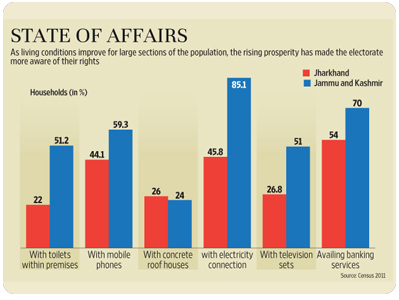Demography Of Jharkhand

As of Census 2011, Jharkhand has a total population of 33.0 million. Of the total population in the state, 16.9 million were males and 16.1 million were females in 2011. The sex ratio (females per 1,000 males) of Jharkhand is 948 which is slightly higher than the national average of 940. The population of the state grew at 22.34 per cent from 2001 to 2011.
According to the Census 2011; the literacy rate of Jharkhand is 66.4 per cent. Male literacy stood at 76.8 percent while female literacy is 55.4 at that time.
Jharkhand has a population density of 414 persons per square kilometer. With 1167 people per square kilometer, Dhanbad is the most densely populated district whereas Gumla is the least densely populated district with 148 per square kilometer. Majority of the state population (about 76%) live in rural areas. Dhanbad, East SInghjbhum and Bokaro are the highly urbanized districts where more than half pof the population live in urban areas. Scheduled castes and scheduled tribes account for 11.8% and 26.3% of the total people living in Jharkhand. Simdega, Gumla, West Singhbhum, Lohardaga and Latehar are the top five districts in the state with highest per cent of scheduled tribe population.
Almost 75per cent of the population in the state is engaged in agriculture or agriculture related activities.
Northern and Eastern parts of Jharkhand are more densely populated compared to the rest of the state.
Despite being home to forty per cent of the mineral resources of the country and large forest over, Jharkhand remains a state with one of the highest poverty rates in India.